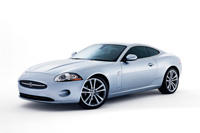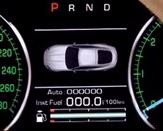 Interesting snippets from the formal launch of Jaguar’s new alloy-bodied XK.
Interesting snippets from the formal launch of Jaguar’s new alloy-bodied XK.
“Inside the cabin the minimalist instrument cluster houses two prominent round dials either side of an advanced high-resolution colour display based on thin-film transistor technology. This display is split into several zones showing vital information such as gear selection, cruise control information, low tyre pressure warnings and satellite navigation instructions, depending on market.” This screen is in addition to a 7-inch display, mounted rather low in the centre console, which offers touch-screen control over ventilation, audio, navigation and telephone settings. No sign of a head-up display, however, despite Jaguar’s boasts of technological leadership. (In fact, as Car Design News notes, the console as a whole looks a generation adrift of its up-to-the-minute rivals.)
This screen is in addition to a 7-inch display, mounted rather low in the centre console, which offers touch-screen control over ventilation, audio, navigation and telephone settings. No sign of a head-up display, however, despite Jaguar’s boasts of technological leadership. (In fact, as Car Design News notes, the console as a whole looks a generation adrift of its up-to-the-minute rivals.)
Jaguar parent Ford is also crowing about the XK’s braking system, which promises to be more responsive as grip begins to run out during those moments when you wish you’d started braking yesterday.
“Unlike conventional digital ABS systems used on many cars, the all-new XK’s ABS system can vary the brake pressure at each wheel using analogue valves in the hydraulic control unit. This gives more refinement to the hydraulic pressure control and allows drivers to benefit from increased steering input during heavy braking.”
The first digital refers to the on-off-on-off action of conventional ABS. No doubt the analogue valves are still commanded by a digital control unit.
Update: Parts maker Continental points out that it has developed analogue braking control components for use in both ABS and stability control systems, and that these are fitted to six-cylinder versions of the latest BMW 3-Series.
New cat out of the bag
30 August 2005



